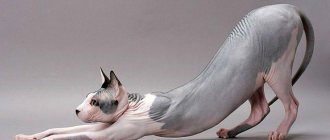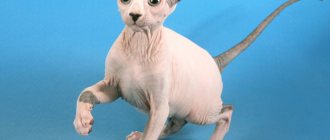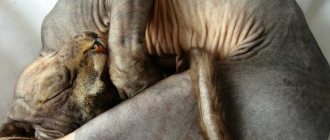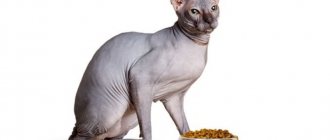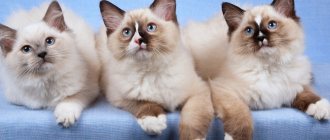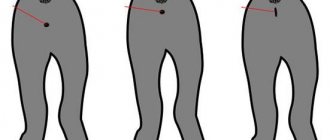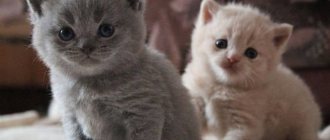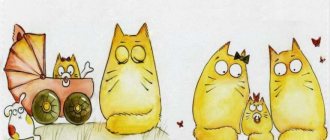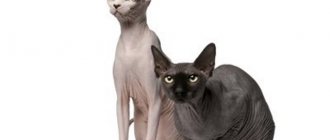Admin 03/01/2018 0 Comments
Ratings and comparisons of breeds
cat breeds, breed ratings and comparisons
How does the Don Sphynx differ from the Canadian Sphynx and which of these two breeds is better? This question is often asked by people who dream of becoming the owner of an exotic hairless pet. After all, it seems only at first glance that all hairless cats are the same; in fact, there are significant differences between them, not only in the history of origin, but also in appearance and even in character.
Definitions
The Don Sphynx is a relatively young Russian breed of hairless cats. Animals have an unusual appearance. Their muscular body is covered with soft silky skin, and large almond-shaped eyes stand out on their expressively defined muzzle. The miniature head is complemented by large protruding ears. The uniqueness of the breed lies in the fact that not all of its representatives are completely hairless. Kittens of some species have pronounced hair, which they often lose with age. The first bald baby, acting as the founder of the breed, was born in Rostov-on-Don in 1990. The breeder's long-term breeding work has borne fruit. In 1996, the breed was officially registered, which over time gained fame throughout the world.
Don Sphynx
Velor Don Sphynx
Don Sphynx brush
Don Sphynxes have a cheerful and playful disposition. These are very friendly animals that easily get along with children and various representatives of the fauna, be it a dog or a rabbit. Cats of this breed are not characterized by rancor and vindictiveness. They dote on their owner, sometimes showing excessive intrusiveness. At the same time, Don Sphynxes remain quite independent and rebellious pets, putting themselves on the same level as humans.
The Canadian Sphynx is a breed of hairless cat that originated in 1966 in North America. It happened completely by accident. An ordinary smooth-haired pet from the Canadian town of Ontario brought kittens to her owners, one of which turned out to be completely bald. The cause of hair loss remains unclear. The main version is single natural mutations, which subsequently began to be preserved and maintained through crossing with smooth-haired cats.
Canadian Sphynx
The body of the Canadian Sphynx is strong and muscular, the head is of medium size with a clearly defined muzzle and protruding ears, the eyes are large and oval. If you run your hand over the soft, smooth skin of a cat, you can feel the presence of a small fluff, almost invisible to the eye. The animal has a long hairless tail, sometimes ending in a neat “tassel”, like a lion’s. Rolled into a donut, it is almost always pressed to the body. By nature, Canadian Sphynxes are very peaceful and loyal animals. They easily get along with other pets and are also distinguished by their healing abilities. This proud cat will never ask for handouts from the owner; it is much easier for her to quietly steal a tidbit from the table.
Which Sphinx to choose
A detailed description of the differences between the Canadian and Don Sphynx is presented in the table.
| Canadian Sphynx | Don Sphynx | |
| History of the breed | Originally from Ontario, breeding began in 1966. | Originally from Russia, the first kittens were born in 1992 in Rostov-on-Don |
| Genetic differences | The recessive hr gene is responsible for the Canadian cat's hairlessness. If crossed incorrectly, it can be suppressed by dominant genes. Then the offspring will not inherit hypotrichosis (thinning hair). | The hairless trait of the Don Sphynx is based on the dominant Hbl allele, formed due to a natural mutation. It consistently transmits parental characteristics to subsequent generations. |
| Kittens | They are born with residual hair on their paws, tail and head, which lasts a lifetime. In practice, there are almost no completely “naked” Canadian Sphynxes. | A water litter can produce kittens of several varieties: rubber (without hair), brushes and flocks. The last two are distinguished by the presence of hairs on the body, but by the age of 2 they “undress”. |
| Constitution | The cat is medium in size, with a muscular body and a well-developed chest. The hind legs are slightly longer than the front legs, which causes the back to rise up just behind the shoulder blades. The large pads of the fingers are noteworthy - the Canadian Sphynx seems to be standing on a thick soft base. | Dense, medium build, with a lean body. The croup of the Don Sphynx is slightly widened due to which the body has acquired a pear-shaped form. The fingers are elongated, well developed and flexible. The paws are of medium length, the forearms are straight. |
| Leather and wool | In the circumference of the shoulder girdle, between the ears and on the head, when stroking, the density of the cover is felt. There is normal hair on the bridge of the nose. The presence of fine small hairs is allowed on the ears, tail and in the scrotum area. There is no mustache on the nose. | The skin of the Don Sphynx is hot to the touch, gathering in folds on the head, under the arms and in the groin area. As adults, Don Sphynxes are completely “rubber”, devoid of integument. They have hard whiskers of varying lengths. Sometimes the hairs on them can break off. |
| Health | Weak resistance to diseases and a low threshold for overcoming pain. | It is believed that the Don Sphynx has a stable immunity to diseases, but requires the creation of comfortable living conditions. |
| Character | There are such traits as isolation and selfishness. Makes contact with a person only of his own free will. | Sociable, especially at a young age. The Don cat is loyal to children and pets, sometimes it is intrusive and requires attention. |
Depending on the conditions of detention, the character and some external qualities of any breed can change both positively and negatively. For some, the Canadian and Don Sphynx personify exotic charm and magical charm, while for others these animals seem to be a real aesthetic misunderstanding.
The difference in tastes is not discussed. What is certain is that having seen a hairless cat once, it is no longer possible to erase it from your memory.
Comparison
Let's start with the origin of the breeds. The Don Sphynx was bred in Russia and officially registered in 1996. This breed is relatively young and is just on the path of its formation. While the Canadian sphinxes have a half-century history. Their homeland is North America. The gene for hairlessness in Don Chaks is dominant. When crossing with smooth breeds, hairless offspring are possible. In Canadians, the hairless gene is not dominant (it is recessive).
Now let's talk about the external features of cats. The main difference between the Don Sphynx and the Canadian one is that the body of the latter is never completely bald. It is covered with a light fluff that is almost invisible to the eye. Whereas the Don Sphynxes are divided into three types. The body of naked cats is completely devoid of hair. Velor representatives of the breed have hair up to 3 mm long. But the Don Sphynxes of the brush type are covered with coarse, curly hair.
Particular attention should be paid to the animals' heads. The skull of the Don Sphynx is wedge-shaped, the cheekbones are clearly visible on the muzzle, and the forehead is noticeably sloping. Vibrissae—hard, curled whiskers—may be present. The Sphynx's skull is slightly rounded, the cheekbones are not so clearly defined, and the transition from the forehead to the nose is clearly visible. The mustache is completely absent. The eyes of the Don Sphynx are almond-shaped, slanted, and medium in size. Canadians have them large and round.
As for the physique, the representatives of the domestic breed have a denser one. The cats' chest is well developed, the muscles are pronounced, and the paws are of medium length. The animal does not jump very far. Its tail is straight, strong and flexible. Canadian Sphynxes look much more graceful. They have thin bones and long legs, making cats excellent jumpers. The animal's tail tapers towards the end and may have a small "tassel". Canadians also have an abundance of folds on the neck and armpits, which cannot be said about the Donetsk people.
It is impossible not to mention the character of the pets. Don Sphynxes are considered more affectionate, docile and curious animals. They are distinguished by good health and good endurance. Whereas Canadians are characterized by some isolation and harshness. Their pain threshold is an order of magnitude lower, and their health sometimes leaves much to be desired.
Let's summarize what is the difference between the Don and Canadian Sphynxes.
Source
Historical information
The Canadian and Don sphinxes appeared in the second half of the 20th century.
- The Canadian Sphynx comes from the province of Ontario. In 1966, the cat family acquired an unusual offspring: a bald baby. The breeders decided to consolidate this feature. American breeders got involved in the process, and as a result of closely related breeds, they were lucky to achieve the desired result. The standard of the Canadian Sphynx cat was recognized by the International Felinological Organization, and the Canadian breed was allowed for breeding and participation in national and international exhibitions.
- The Don Sphynx is a species bred in Russia. The work began in 1986 in Rostov-on-Don. The cat of breeder E. Konovalova, named Varvara, began to lose hair on her back and head. The treatment did not produce any results. The owner of one of Varvara’s kittens, Irina Nemykina, began experiments with matings and achieved amazing results. The daughter of a cat from Rostov consistently gave birth to hairless kittens. In 1996, the Don Sphynx breed was officially registered.
The history of the origin of the Canadian and Don Sphynx
The first Canadian Sphynx was born about 50 years ago in Canada. The kitten's name was Prune, and he differed from his brothers in the absence of fur. Prune's owners decided to breed a new breed, but mated him with females from the same litter. The offspring were born non-viable and died.
Canadian Sphynx kitten
The second hairless kitten also appeared by chance, but this time in the American city of Waden. He was named Epidermis, and felinologists were more careful in breeding, not allowing him to mate with close relatives. This is how the Canadian Sphynx breed was developed.
The history of the appearance of the Don Sphinx is more fascinating. In 1986, in Rostov-on-Don, Elena Kovaleva saw how boys were torturing a small kitten. She saved the baby and sheltered him, giving him the name Varvara. After some time, the cat began to lose hair on her back; treatment did not produce results.
The history of the origin of “bald” breeds
The official history of the Sphynx is very short, but hairless cats, as a result of a genetic mutation, have appeared next to humans since ancient times. Attitudes towards this miracle of nature could be very different: in ancient times they were attributed healing and almost magical qualities, in the Middle Ages they were burned for.
Hairless cat - a genetic error or a miracle of nature?
There is information about an ancient breed of hairless Mexican cats, which, unfortunately, completely disappeared at the beginning of the last century. But these legendary hairless cats and modern hairless cats have a common origin, based on a spontaneous genetic mutation, fixed and passed on to offspring.
This is what hairless Mexican cats looked like
There are several known hairless cat breeds, both generally recognized and experimental. Some of them were obtained by fixing a spontaneous mutation, and the rest were the result of interbreeding.
Photo gallery: modern hairless cats
The Canadian Sphynx as a breed has a history of half a century ago.
The Don Sphynx is a young, but very popular and promising breed of hairless cats.
Petersburg Sphynx, or Peterbald - to create the breed, the blood of oriental cats was infused into the Don Sphynxes. Ukrainian Levkoy - a derivative of the Don Chak and Scottish Fold
Elf is a product of crossing Canadian Sphynxes with American Curls
Bambino is a miniature cat obtained from the union of Canadians and munchkins.
Dwelf is the fruit of a triple selection of Curls, Munchkins and Canadians
The Cohona, or Hawaiian Hairless, is the result of a mutation, a breed so rare that its very existence is in question.
Don Sphynx
The Don Sphynx is a young breed of Russian selection. It is generally accepted that all Don Chaks descend from the cat Varvara, a blue-cream “tortoise” who was found by a kind woman in Rostov-on-Don in February 1986 as a very small kitten. Having picked up the unfortunate baby just on the street, Elena Kovaleva fed her and treated her, but the cat’s fur did not grow back. The cat's body was velor, and its tail, paws and frill remained fluffy.
Moreover, when the matured Varvara became a mother, a hairless kitten was found in the litter, also a girl, named Chita. It is from this moment—since 1990—that the official history of the Don Sphinxes begins. Elena’s friend, Irina Nemykina, although she was not a felinologist at that time, was the first to recognize the signs of sphinxes in the amazing cats. Having received baby Chita as a gift, she actively began self-education and selection of a new breed.
Irina Nemykina and her cat Chita “invented” a new breed of Sphynx
The first breeding nursery of the Don Sphynx was called “Myth”; the famous cat Hannibal, who is in the pedigree of every Donchak, was obtained here. Close crossing of Hannibal with his mother Chita made it possible to obtain completely hairless kittens and fix the genotype of the new breed. Strange cats - Sphynx cats of Russian breeding - were shown at exhibitions of aboriginal breeds, and they very quickly gained popularity.
In 1992, the number and quality of the livestock made it possible to create the first, experimental standard of the domestic breed, and in 1998, the Don Sphynxes finally received international recognition at the conference of the World Cat Federation (WCF), and at the same time the final name of their breed, which until then was called differently:
- Don balder;
- Russian hairless;
- Russian naked.
Irina Nemykina with her modern pet
However, the name does not change the essence of the fact that the young breed of Sphynx of Russian selection quickly became famous, popular and in demand throughout the world. Today there are four breed standards:
- ICEF;
- WFF;
- MALK RUI;
- WCF.
An adult Donchak looks unusual and solid
Such well-known felinological organizations as FIFE and TICA are also considering the issue of recognizing the Don sphinxes.
Video: all about the Don sphinxes
Canadian Sphynx
The first attempt to create a breed of Canadian Sphynx was, alas, unsuccessful. It dates back to 1966, when a hairless kitten, Prune, appeared in a litter of ordinary domestic cats from the province of Ontario, which immediately attracted the interest of local felinologists. Despite their efforts, it was not possible to create a new breed based on this random mutation.
“Lysik” Prun was actively mated with his mother, sisters, daughters and just cats of different breeds, but the hairless offspring that resulted were small in number, weak, and unstable in phenotype. In addition, the breeders did not have a common strategy and a unified vision for the new breed, which, by the way, immediately received the name “Canadian Sphynx” and experimental status from the CFA. This felinological organization was forced in 1971 to revoke the status it had issued.
Sphynx cats are sometimes called "moon cats"
A second chance appeared only nine years later, with the birth of a naked baby to another parent couple. A kitten named Epidermis eventually became the ancestor of the Canadian Sphynx. Around the same time, three more “balds” were found just on the streets, two of whom took a direct part in the formation of the breed.
At the first stages of selection, Devon Rex blood was actively infused into the small Canadians to expand their gene pool and create the desired type, features of which to this day are sometimes visible in purebred Canadian Sphynxes. Experienced American and European felinologists carried out breeding work in the breed. All authoritative felinological organizations in the world today have already recognized the Canadian sphinxes.
Video: everything about the Canadian sphinxes
Difference in Exterior
Are there any differences in the appearance of the Don and Canadian Sphynx? Despite the fact that these breeds are similar, experienced felinologists accurately determine which type of cat a particular animal belongs to. Lack of fur is not the only sign by which breed is determined; other differences in appearance are also important.
Comparative characteristics of the Canadian and Don sphinxes:
| Exterior | Canadian Sphynx | Don Sphynx |
| Torso | The body is large with well-developed muscles. The chest is wide and round. | Medium or large. Strong muscles and skeleton. |
| Tail | Thin, sharp at the tip, where there is often a brush. | Medium length, mobile, straight. |
| Head | Short and wide head with a pronounced transition from nose to forehead. Vibrissae are completely absent. The neck is of medium length. | The head is wedge-shaped with prominent brow ridges and cheekbones. There are many skin folds and wrinkles on the head. Vibrissae may be absent; if present, they curl. The neck is long and graceful. |
| Eyes | Large and wide open, set close together. Amber color. | Almond-shaped, medium in size, slightly slanted, do not open widely. Can be any color. |
| Ears | Large, wide at the base, set straight. | Wide at the base and set straight. Slightly tilted forward. The ends are rounded. |
| Leather | Thick with numerous folds. They come in white or piebald. | Not all of the body is covered with folds: on the head, in the groin, in the armpits, on the stomach. The color can be any. |
Similarities and differences between Sphynx cats
At first glance, the Canadian and Don Sphynx are similar in appearance, but experts know that each breed has an individual set of characteristics, and the difference in appearance and character is quite significant.
Future owners who dream of a hairless friend should also know about this. It is important to understand which breed your heart lies in in order to make the right choice.
The difference between genotypes is reflected in the nature of the coat. If Canadians, in most cases, have a weak coat, then Don Chaks often have completely hairless (rubber) varieties. Those types (flock, brush, velor) that are not devoid of hair, over time, become hairless (but, in some cases, the coat remains).
Appearance
Upon careful examination, you will notice that external differences between the Canadian and Don Sphynx still exist. This is confirmed by breed standards. To make a visual comparison, it is convenient to summarize the descriptions of appearance given by the CFA and WCF standards in a table.
Table: Canadian and Don Sphynxes according to CFA and WCF breed standards
| Stati | Canadian Sphynx (CFA standard) | Don Sphynx (WCF standard) |
| general description | Medium cat breed. There is sexual demorphism (cats are much smaller than males). The body is covered with short fluff. Body temperature is higher than that of cats of other breeds. | The body is of standard size, velvety to the touch and hot. Sexual demorphism is pronounced. |
| Head | The head is a “modified” wedge, slightly lengthened towards the nose. The transition from the cheekbones to the nose is somewhat pronounced. There is a rounding in the area of the back of the head. The nose is straight, the transition to the forehead line is preceded by a hollow. | The head is an elongated wedge with a flat forehead. The transition to the forehead is significantly marked. |
| Cheeks, cheekbones | The cheekbones are pronounced, the pads of the mustache protrude, making the muzzle somewhat square. The arches of the cheekbones are pronounced. Vibrissae are absent or severely broken off. | The pinch is light, slightly rounded. The arches of the cheekbones are clearly visible. Vibrissae are present, but may be broken off. |
| Muzzle, chin | The muzzle is slightly longer. The chin is strong and well developed. | The muzzle is of medium length, the whisker pads and chin are well developed. |
| Neck | The neck is short, well developed, muscular, strong. Represents a non-steep arc. | Muscular, strong, this is especially noticeable in cats; in cats it is more graceful. |
| Ears | The ears are large, set vertically, and much wider at the base. There is no wool inside. The base line coincides with the line of the eyes. | The ears are large, set vertically, the line of the ears is slightly inclined forward, the tips are rounded, the shell is wide open, there is no hair inside. |
| Eyes | Large eyes, oblong (lemon-shaped), slightly slanted, eye sockets widely spaced. Any shade of the iris is allowed (mainly in the color of the coat). | Medium, set wide and slightly slanted. The eye shape is average. The upper eyelids droop moderately. Any iris color is allowed. |
| Body | Medium body with strong bones and powerful muscles, looks heavy. The belly is full, rounded, the chest is well developed. The hind legs are long and provide an elevated position of the croup. | The body is medium in size, with a developed skeleton and muscular frame, a dense build type. Because of the retracted groin line, the animal looks lean. Wide chest. |
| Paws | The paws are quite large, rounded, and equipped with long, movable toes. The pads are well developed. | The paws are round, large, the toes are well developed, equipped with membranes and dense, retractable claws. |
| Tail | The tail is quite long (length is proportional to the body). The coat is weak or absent, when at rest it is curled and pressed against the body to the right or left of the spine. | Long (at least half the body length), hairless, tapering towards the end. Straight. |
| Integumentary tissues | Appears hairless, but in most cases a small coat of hair is present, especially on the ears (outside the auricle), paws, tail, and genitals. The bridge of the nose is pubescent. The skin is strongly folded, very dense. | The skin is very folded. Young cats often have slight hairiness that disappears over time. Kittens are born with a coat of wavy, fine fur. Another feature is that the eyes open early (often already on the first day of life). |
| Color | The standard allows any colors, including colors with white markings on the body. Zonal dyeing of wool is not allowed. | Any colors are allowed. All varieties of tabby colors are combined into one group. |
Character of the Sphynx breed
Both cat breeds are distinguished by their active, sociable, affectionate, and friendly nature. But there are still some character traits.
The Don Sphynx almost never demonstrates self-will and aggression. This playful baby can be safely taken into a family with small children as an ideal companion for games and pranks. In addition, Donetsk people are very curious, smart, and cannot do without communication. They easily find a common language with all family members (even four-legged ones).
Something else interesting: Cats with a high level of intelligence
It is easy to distinguish the Canadian Sphynx: it is more reserved and cautious. He needs one and only owner, to whom he will give all his love and devotion. The cat literally follows on the heels of his chosen one, strives to be privy to all his affairs, and arranges moments of tenderness and affection. He behaves more calmly with other family members, although he is also quite friendly. But he doesn’t like strangers, avoids them, and shows distrust. Doesn't get along well with other pets. He will be an ideal companion for a single person or for a family without small children.
For cats of both breeds, communication is vital. They absolutely cannot stand loneliness, they get bored and even become depressed. Left alone, they start a riot, turning everything in the house upside down.
Aggressive behavior on the part of cats is considered a serious deviation from the breed standard. In this case, the sphinx is rejected, even if all other breed qualities are ideal.
Health, life expectancy
The lack of fur in both breeds can cause skin pathologies. The active work of the sweat and sebaceous glands leads to rapid contamination of the skin. Hairless cats should be bathed frequently (at least once a week), and in between baths, treat the skin with a disinfectant solution. If this is not done, the risk of developing pustular pathologies, dermatitis, and abscesses increases.
In addition, cats are susceptible to the following diseases:
- colds (animals should be protected from drafts and dressed in the cold season);
- sunburn (the sphinx cannot stay under the scorching sun for a long time)
- allergic reactions (possible when skin comes into contact with aggressive substances);
- eczema (nonspecific skin diseases).
There are a number of genetic pathologies characteristic of sphinxes. Their carriers are recognized as defective breeds and are excluded from the breeding program:
- malocclusion due to a shortened lower jaw;
- microphthalmos (impaired development of the eyeball);
- curvature of the tail (hereditary pathology leading to severe complications);
- vasculitis (diseases of the vascular system);
- inversions and inversions of the eyelids.
- hyperplasia of the mammary glands (typical for the female half).
The Don Sphynx has a naturally strong immune system and good endurance. The above diseases are diagnosed in them relatively rarely. In the Canadian Sphynx, differences are manifested in a lower pain threshold and a greater predisposition to pathologies. Most often, kittens and young cats, whose own immune systems are still weak, get sick. Adult cats rarely get sick if they are well cared for. The average lifespan of a Canadian and Don Sphynx is 12-15 years, and, with ideal care, even more.
Features of the coat
There is an opinion that sphinxes are completely hairless cats, without a single hair. This is not true: they can also be completely covered with fluff or only in certain areas of the body. The photo below shows sphinxes with different coats.
Sphynx kitten
The presence or absence of hair is one of the characteristics by which the Canadian Sphynx differs from the Don Sphynx. Canadian Sphynxes are never born naked; moreover, completely hairless individuals are not found among them - any Canadian is slightly hairy. In some areas of the body, hairs can reach a considerable length: on the face, ears, limbs, tail.
Based on the type of coat, Donchak dogs are divided into the following types:
Do sphinxes differ in character?
Differences also appear in character. Canadians are more independent and self-reliant. They do not consider a person to be their master, but behave on an equal basis with other family members. They do not need increased attention and get along well without playing with people. Donchak dogs, on the contrary, are very attached to their owners. They are obedient, friendly, and show more submissiveness than independence.
When a stranger comes into the house, Canadians hide away. When you try to pet them, they may hiss and try to bite or scratch. Donchak people, on the contrary, will treat the guest with curiosity and even allow themselves to be petted.
You should not get another pet if there is already a Sphynx living in the house. These cats are jealous, they will not tolerate competition with another pet, so there will be constant fights between the two animals. Don Sphynxes, on the contrary, will be very friendly towards a new four-legged family member.
What these cat breeds have in common is their high intelligence. They are very smart, inquisitive, easy to train and quickly learn to use the litter box.
Hairless Sphynx cat: character
The unique character of the Sphynx, as well as their appearance, is the result of careful selection. These animals are not prone to displaying aggression or discontent. Kind, soft, sensitive, gentle, devoted Sphynxes are ideal pets.
They get along well with both older people and families with small children. A balanced character combined with a playful disposition helps these animals share the interests of each family member.
Sphynx cats get along well in families with small children.
IMPORTANT: Sphinxes are not vindictive, they quickly forget random insults, but they have a hard time experiencing loneliness.
Sphynxes love to interact with people and pets. They are not afraid of large dogs and lack the hunter's instinct, so a hairless cat's best friend can be a huge bulldog, a hamster or a parrot.
Sphynxes are playful and curious animals
How can you tell one sphinx from another?
They have different head shapes, and these cats also differ in size (the Canadian is larger). Another distinctive sign that will be clear even to an inexperienced person is the presence of folds on the body. Many thick folds indicate a Canadian.
Not every representative of the breed has pronounced breed traits, especially if there were crosses with other sphinxes in his pedigree. If in doubt, it is best to consult a veterinarian or professional breeder.
Source
Differences between the Don Sphynx and the Canadian Sphynx
Gone are the days when sphinxes - hairless cats - were a real curiosity. Today, many people have such pets, and they are no longer perceived as something extraordinary. For most people who are not specialized felinologists, all sphinxes look the same; they are just cats that have a very unique appearance with no fur. However, within this breed there are different varieties that differ from each other. It is not easy for the average person to distinguish the Don Sphynx from the Canadian one. Let's look at what these breeds are and which one is preferable for someone who decides to get a hairless kitten.
Owner reviews
According to them, any sphinx is suitable for interacting with people. Despite the differences, which are noticeable only to those who know at least a little about this breed, the docile Donets and the sharp, reserved Canadians make excellent pets.
This is not to say that any of them are better. Everyone has a unique set of qualities that makes them unique. Pets with an unearthly appearance both attract and repel those who have not yet tried to touch their body and soul.
If you have not yet understood how one species differs from another, do not despair. You still have time to meet incredible creatures who are eager to communicate with you.
Description and history of the Canadian Sphynx
The history of the breed goes back more than 50 years, since 1966. However, there is evidence that such cats were already encountered in ancient times. They began to be specially bred only in the mid-20th century in Canada. Today, the Canadian Sphynx is a breed recognized by all felinological organizations.
These cats have a gene responsible for the lack of hair. It is transmitted in a recessive manner. The reason for the appearance of this gene mutation is unclear. But at one time, experts began to breed a breed of hairless cats, crossing hairless animals with short-haired ones, maintaining and preserving the trait.
The body of the Canadian Sphynx is graceful, with well-developed, proportional legs. The head is small, round in shape. No mustache. The eyes are large, round, and the color of the iris is most often yellow. The ears are large and very wide at the base. Despite the fact that Sphynxes are called bald or hairless, Canadians always have a barely noticeable fluff on their body.
Different breed genetics
Canadian Sphynx cats are not allowed to be mated with other breeds. The hairless mutation in the offspring of these cats is guaranteed by the recessive HR gene. The original breeding involved Devon Rex, and HR continues to provide information about the differences in the genome of their offspring.
The appearance of the Don Sphinx is a pure coincidence. Domestic breeders were inspired to develop a new breed by the existence of their Canadian counterpart. But the true cause of the baldness of the ancestor of the breed has not yet been determined. Most likely, hair loss is caused by the presence of a dominant HBL allele, a gene responsible for the development of certain traits.
Important! Genetic difference between the Canadian and Don Sphynxes in the cause of hair loss. In the domestic species, the anomaly is caused by a dominant gene. For a Canadian, it is repressed (recessive).
How to distinguish a Don Sphynx from a Canadian one by appearance The difference between the two hairless breeds is obvious when carefully studying individual parts of their portrait:
| Comparison options | Canadian Sphynx | Don Sphynx |
| Body | Elegant, fine-boned. | Dense, with a well-developed chest. |
| Paws | Long, elastic. The front legs are longer than the hind legs and crooked. | Middle length. |
| Tail | Tapered at the end, with a tassel that gives it a lion-like appearance. | Straight, flexible and resilient. |
| Leather | It has many folds on the neck and armpits, and is covered with barely noticeable, short fluff. | Smooth, without hairs. In some species, kittens have fur at birth, which subsequently falls out. |
| Head | Rounded, with pronounced cheekbones and an indistinct transition from forehead to nose. | Wedge-shaped, sloping forehead, clearly prominent cheekbones. |
| Eyes | Large, round shape, various shades. | Medium size, almond-shaped, slanting, often amber in color. |
| Neck | Medium length, muscular, slightly arched. | Graceful and strong at the same time. |
| Ears | Large, wide at the base, with a slight edge on the outside. | Set high, slightly leaning forward, with rounded tips. |
Main differences between breeds
| Characteristics | Canadian Sphynx | Don Sphynx |
| Body | Elegant, quite compact, with long limbs, folds on the skin, localized mainly in the armpits and in the neck area. The animal is very graceful. | Quite squat, but proportional, with well-developed legs, a wide chest, good muscles. |
| Head | Small, prominent, with a clearly visible transition from the forehead to the nose. | Wedge-shaped, with well-defined cheekbones, wide at the top and tapering downward. |
| Ears | Large, set quite low, widely spaced. | Large, long, straight, located high. |
| Eyes | Large, round, wide open. | Almond-shaped, set slightly at an angle, small in size. |
| Mustache | None. | They may be small, as if broken off, sometimes they resemble small bent antennas. |
| Hairline | Barely noticeable fluff. | Completely absent, some individuals have a little hair on the head, paws, and tail. |
| Teeth | Good teeth, but some individuals have a predisposition to teeth diseases. | Strong, white enamel. |
| Jumpability | Due to their body structure, they jump well and far and can move to a fairly high place. | Not very jumpy. |
| Character | Soft-spoken, friendly, can be a little reserved. | A curious and active animal with a strong psyche, contented and willful. |
| Genetic characteristics/hairlessness gene | Recessive. | Dominant. |
What is the difference?
An experienced breeder or amateur will determine at first glance who exactly is in front of him. Detailed information about the difference in appearance and habits will help everyone else understand this issue. It must be considered according to several criteria.
Build
The first type has a wedge-shaped skull, sharply defined cheekbones, and a sloping forehead. The physique is dense , the chest is quite developed. Limbs of medium length, moderate ability to jump over long distances. The tail line is straight. It is strong and flexible.
The second has a rounded skull, less clarity in the lines of the muzzle, except for the bridge of the nose. The shapes are more graceful, the bones are thinner. Long legs, excellent jumping ability. The tail is narrowed; a “lion” tassel can stand out at the tip.
Sight
In both species it is magical, attracting to itself like a magnet. Only the Don Sphynxes have almond-shaped, slanted eyes, while their opponents have large, round eyes.
Hairiness degree
In the first case, naked gene carriers are completely hairless animals. Only the brush is born with hairs in the form of hard curls . Sometimes there are mustache curls. The skin is smooth.
Mr. Cat recommends: genetic characteristics that determine hair type
The most important difference between the Don and Canadian Sphynx is that the hairless gene is transmitted in a different type. In Canadians, the gene that determines the lack of hair is recessive. That is, it is capable of ensuring the manifestation of hairlessness only when paired with the same recessive allele. If a dominant allele is present, the trait is suppressed. For this reason, Sphynx cats usually have a little fluff on their bodies.
In Don Sphynxes, the gene for hairlessness is dominant, suppressing recessive alleles, so this trait is fully manifested in the offspring. Cats can be completely hairless, sometimes there is a little hair on the head, tail, and limbs.
Canadians have no mustache at all, while Donetsk people may have small whiskers. Breeds differ in body structure, head and ear shape.
Differences between breeds
The difference between the breeds begins with their history of origin: the Don Sphynxes, which recently appeared, trace their history back to Russia, while the Canadian ones have already half a century behind them, and even came from the overseas continent.
In the former, the lack of hair dominates in the processes of crossing with breeds with smooth and short hair, and in the latter, the gene for lack of hair is recessive (suppressed).
Breeds also differ in appearance. Canadians, as already mentioned, have a light fluff on the surface of their skin. It is practically invisible to the eye, but it is there. But the Don Sphynxes have both bald and “woolly” varieties.
Almost all of them are born naked, and as they grow up, they begin to acquire distinctive species characteristics. There are three species in the breed. One has no fur at all. Cats of the velor breed are covered with short hair up to 3 cm long. But the Doncha cats of the brush type have hard, curly hair.
Comparison of characters
The nature of the breeds differs quite greatly. Don Sphynxes are playful and very inquisitive. These are excellent pets for families with children, as they are not prone to display aggression. If there is a very small child in the family, then his contact with the cat should be limited for the safety of the animal itself. Babies are not very good at playing with cats and can damage their delicate skin. Older children should clearly understand that they need to behave carefully with the cat so as not to harm it. When adults are convinced that the child understands how to behave, then you can leave them to play together without any problems. The Sphinx will support any fun activity.
Donchak people are very curious, love to be the center of attention and consider themselves obliged to take part in all events taking place in the house. They really need to communicate with a person, they can literally beat underfoot without leaving a single step. Sometimes they even become intrusive, but there are no more devoted and selfless friends.
They usually adore their family members. They treat strangers quite friendly and with interest. They may willingly go into their arms, but this does not apply to all Donetsk people. They get along well with other animals.
Compared to their Russian counterparts, Canadians are distinguished by their isolation, caution, and secrecy. They most often choose one person as their master, giving him their love and tenderness. They behave quite friendly with the rest of the family, but you can immediately see who the animal’s favorite is. They do not get along well with other animals.
Canadian Sphynx dogs are distinguished by their reserved manners. They never allow themselves to impose their company, beg for food, or do any other similar things. They will not allow themselves to be offended, and in relationships with people they demand equality, partnership, and mutual respect.
Features of feeding
Don Sphynx cats have a good appetite. Compared to furry cats, they spend much more energy on heating.
In this regard, sphinxes are partial to food. They are happy to try new products. Sometimes their preferences are puzzling. Some representatives of this breed can go crazy over such atypical foods for cats as candy, rolls, watermelon, potatoes, cucumbers, etc.
It is allowed to feed such cats with both natural food and industrially produced food. In the first case, you should fill the cat's bowl with high-quality meat: beef, lean pork, you can add chicken, turkey. Low-fat fish is also allowed. “Garnish” can be vegetables and cereals.
If you decide to feed your Don Sphynx with ready-made food, premium and super premium class food is best.
Also, premium and super premium food classes are suitable for sphinxes. Breeders of this breed give good recommendations to the brands Acana, Orijen, Innova, Evo, Felidae.
Caring for the Don and Canadian Sphynx
There are generally no differences in the maintenance and care of both breeds. Cats that have little or no hair need special care for their skin. Both Canadian and Don Sphynx cats should be bathed frequently, approximately once every two weeks. Kittens are washed in a basin; an adult animal can be washed directly in the bath. For bathing, soapy water is made at a fairly high temperature: the pet should not be cold. You need to wash your Sphynx thoroughly, using a soft washcloth to treat all areas of the body, making sure to wash the skin folds.
Sphynx diseases
Due to their unique appearance, the main problems for sphinxes arise with the skin. Due to the intense work of the sebaceous and sweat glands, representatives of this breed may experience problems. If the animal's skin is not cleaned daily and bathed regularly, then pustules begin to form and acne appears.
When such problems appear in your pet, you should take him to the veterinarian. The doctor will prescribe treatment and give recommendations for caring for problem skin.
Diseases of the Don Sphynxes are mainly associated with various negative effects and skin lesions. The animal may experience the following problems:
- colds due to hypothermia (the sphinx can get sick even from a short stay in a draft or in a cool room);
- sunburn: exposure to direct sunlight is also contraindicated for sphinxes, as is cold (there are special creams to protect against the harmful effects of the sun);
- inflammatory skin diseases (dermatitis) that occur due to exposure to allergens, deficiency of the iodine-containing hormone thyroxine;
- trichophytosis (dermatophytosis or ringworm) is an infectious disease caused by fungi;
- allergic reactions that appear on the skin;
- eczema is a nonspecific inflammatory skin disease, manifested by skin rashes, itching, and severe discomfort.
Canadian Sphynx
All these pathologies are also found in Canadians, since they are also hairless. Canadian Sphynx cats are susceptible to the following diseases, which can also occur in Donetsk cats:
- a shortened lower jaw is a congenital developmental anomaly that may not cause harm to the pet, but when excessively expressed it causes serious damage to the oral cavity due to malocclusion (all cats with such a defect are excluded from breeding);
- microphthalmos – underdevelopment of the eyeball, often accompanied by other disorders and lesions of the visual apparatus: keratitis, cataracts, tumors, orbital cysts;
- curvature of the caudal part of the spine is a hereditary pathology, very common in sphinxes, accompanied by underdevelopment of the lower intestines, short thoracic and lumbar spine (kittens with such an anomaly are usually not viable);
- immunopathological inflammation of blood vessels (vasculitis);
- nipple hyperplasia is a hereditary anomaly transmitted through the female line (sometimes accompanied by underdevelopment of internal organs, which makes kittens unviable);
- Entropion is a genetically determined congenital defect, manifested by the edges of the eyelids being turned inwards (this pathology must be eliminated surgically, otherwise the animal will develop a chronic inflammatory process of the eye mucosa);
- “Kitten falling asleep” is a genetic disease accompanied by underdevelopment of internal organs, making kittens unviable (usually observed in a litter born as a result of crossing two hairless Don Sphynx cats).
Canadian Sphynx
Mating
Males of these breeds reach sexual maturity by the age of one year; in females, the first estrus usually occurs at the age of 6-8 months. There is no need to breed sphinxes during this period. It is recommended to carry out the first mating at the age of 1.5-2 years; by this age they can already produce full-fledged offspring.
Traditionally, the female is brought to visit the groom, whose owner prepares all the conditions for the “wedding.” The most favorable moment for this is 3-5 days of estrus. Cats should be comfortable and not be distracted by anything. For the bride, you need to prepare a place where she can hide if suddenly she actively does not like the proposed groom.
Before mating, both animals must be examined by a veterinarian and their claws trimmed. A course of anthelmintic drugs must be administered within 2-3 weeks. It is strictly not recommended to bathe a cat before mating. The cat must feel the specific smell emitted by the animal during the period when the hormonal background is most consistent with procreation.
Description of the breed
Without a certain competence in the field of knowledge about it, it is difficult to distinguish between being a Donchak or a Canadian . In fact, both varieties have their own characteristics that are unique to them. Each type has its own set of characteristics.
Don sphinxes
They have Russian roots. The breed was developed through a natural process of mutation. Its representatives cannot have lint. Its absence can be complete or partially manifested. Depending on this, three subgroups are distinguished:
- rubber - they immediately lack a fur coat,
- velor – velvety to the touch,
- Brush - owners of short fur, which disappears at 1.5-2 years.
The muzzle has the outline of a wedge, the cheekbones and eyebrows protrude sharply. The body is muscular, wide croup. The chest is large in volume. The paws are well developed, with long and tenacious fingers on their rounded pads, similar to a human hand. There are short whiskers that help to navigate in space.
Canadian
They cannot be completely hairless - there is a thick layer of hair on the limbs, groin and tail. No mustache at all. The head is small, wide cheekbones. The transition to the nose is clearly defined. The distance between the straight ears is large.
The eyes are round and lemon-like. The gap between them is equal to the size of one of them. The color matches the main color.
The parameters are average. The muscles are normally developed, but the animal looks graceful. The skin feels like velor to the touch due to the short fuzz - up to 1-2 mm. It gathers into folds in the area of the ears, shoulders and muzzle.
